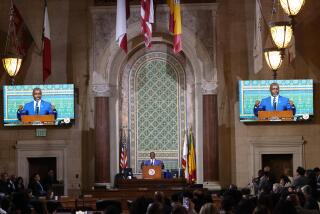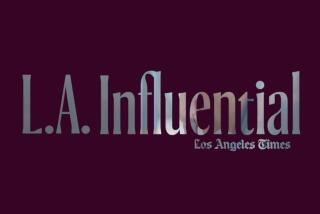United in their hope for city’s future
“Los Angeles is a city that is profoundly invisible to itself.”
-- Harold Meyerson, editor-at-
large of the American Prospect,
in “The New Los Angeles”
*
Before he saw “The New Los Angeles,” Bong Hwan Kim, a fair housing advocate in Pasadena, doubted that any film could really capture the rapid social and economic changes in Los Angeles over the last three decades. The city is so disparate, stereotyped and divided, and its image so glamorously airbrushed by “Baywatch,” that “Los Angeles confounds people, even people who live here,” said Kim, one of a dozen observers featured in the documentary that aims to redefine the city in light of two decades of demographic and economic upheaval.
That the film succeeds was evident Wednesday -- at least to Kim and 350 other activists; business, civic and religious leaders; and hotel housekeepers who walked down a red carpet for the film’s premiere at Paramount Studios in Hollywood.
Judging by the cheers (for labor leaders such as Maria Elena Durazo) and hissing (for former Gov. Pete Wilson), the diverse group appeared to agree the film captures their rarely depicted image of Los Angeles: the ongoing civil rights struggles of immigrant workers and an arc of progressive “coalition” politics from former Mayor Tom Bradley to current Mayor Antonio Villaraigosa.
Former Mayor Richard J. Riordan makes a brief appearance, former Mayor James K. Hahn none at all.
Madeline Janis-Aparicio, executive director of the think tank Los Angeles Alliance for New Economy, said the film moves her to tears every time she sees it.
The documentary uses rarely seen historical footage of hotel housekeeper Victoria Vergara and other picketers being arrested and carted away by helmeted Los Angeles Police Department officers. The late Miguel Contreras, head of the Los Angeles County Federation of Labor, who married Durazo, now the interim head, is also featured prominently.
Third in the four-part PBS series “California and the American Dream,” the film by veteran producer Lyn Goldfarb will air at 10 p.m. Thursday on KCET.
Another showing for the general public will be at 6:30 p.m. Monday at the First A.M.E. Church in Los Angeles.
Goldfarb said in an interview that she was interested in the story of Bradley, the first African American to be elected mayor of a largely white city, who “built important coalitions between African Americans and Jews that were never heard of before.”
“I stand on the shoulders of Tom Bradley,” said Villaraigosa, who spoke to the audience after the screening.
He described Bradley as an “invisible man” who withstood “incredible bigotry” to bring factions of the city together. “He is and will be L.A.’s greatest mayor,” Villaraigosa said.
The film was begun three years ago, before Villaraigosa had decided on his second bid for mayor.
“We started with Bradley,” Goldfarb said, “and realized that Villaraigosa also is building a coalition -- though it’s not exactly the same -- that was absent since the time of Bradley.”
“Coalitions helped build L.A., and coalitions will help carry us into the future,” she said. The film notes that Los Angeles is a city with a majority of minorities -- a trend expected to spread nationwide. “Right now we are a model,” Goldfarb said.
“The New Los Angeles” uses historical footage of local unrest: the 1992 Rodney G. King riots, hotel and liquor store pickets and protests against Proposition 187, the 1994 ballot initiative that sought to cut off most public services to illegal immigrants. (Production had ended before the recent protests against proposed immigration reforms.)
“The film brings us up to where we are today. We need to know how we got here,” Goldfarb said. “The film raises important questions: What are our values, what do we want?”
It skirts some darker questions, as raised in the Academy Award-winning film “Crash,” about the extent to which racism remains a factor in daily life, to focus on history, protests and solutions.
“I’m not a Pollyanna, but I’m a believer that this city is a shining light. Our strength is our generosity and our yearning to make it work,” Villaraigosa said.
As Kim points out in the documentary, many of the movies and TV programs Hollywood churns out continue to reinforce racial stereotypes about the city. Many poor immigrants who have had their views of L.A. shaped by “Baywatch,” a popular U.S. television export, are surprised to find themselves living in low-income, segregated communities with no Anglos in sight, he said.
Their challenge now, as in the past, is to figure out where they fit in.
The blacks, Anglos, Asians and Latinos who were chatting happily in the Paramount theater lobby can all get along because they have enough money, Kim said.
“We still have a ways to go.”


